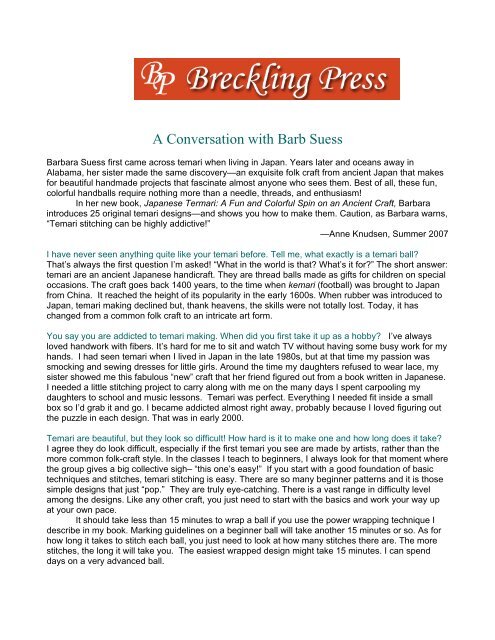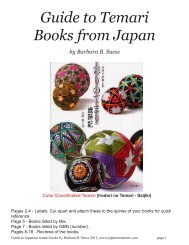Conversation with Barb Suess - Japanese Temari
Conversation with Barb Suess - Japanese Temari
Conversation with Barb Suess - Japanese Temari
Create successful ePaper yourself
Turn your PDF publications into a flip-book with our unique Google optimized e-Paper software.
A <strong>Conversation</strong> <strong>with</strong> <strong>Barb</strong> <strong>Suess</strong><br />
<strong>Barb</strong>ara <strong>Suess</strong> first came across temari when living in Japan. Years later and oceans away in<br />
Alabama, her sister made the same discovery—an exquisite folk craft from ancient Japan that makes<br />
for beautiful handmade projects that fascinate almost anyone who sees them. Best of all, these fun,<br />
colorful handballs require nothing more than a needle, threads, and enthusiasm!<br />
In her new book, <strong>Japanese</strong> Termari: A Fun and Colorful Spin on an Ancient Craft, <strong>Barb</strong>ara<br />
introduces 25 original temari designs—and shows you how to make them. Caution, as <strong>Barb</strong>ara warns,<br />
“<strong>Temari</strong> stitching can be highly addictive!”<br />
—Anne Knudsen, Summer 2007<br />
I have never seen anything quite like your temari before. Tell me, what exactly is a temari ball?<br />
That’s always the first question I’m asked! “What in the world is that? What’s it for?” The short answer:<br />
temari are an ancient <strong>Japanese</strong> handicraft. They are thread balls made as gifts for children on special<br />
occasions. The craft goes back 1400 years, to the time when kemari (football) was brought to Japan<br />
from China. It reached the height of its popularity in the early 1600s. When rubber was introduced to<br />
Japan, temari making declined but, thank heavens, the skills were not totally lost. Today, it has<br />
changed from a common folk craft to an intricate art form.<br />
You say you are addicted to temari making. When did you first take it up as a hobby? I’ve always<br />
loved handwork <strong>with</strong> fibers. It’s hard for me to sit and watch TV <strong>with</strong>out having some busy work for my<br />
hands. I had seen temari when I lived in Japan in the late 1980s, but at that time my passion was<br />
smocking and sewing dresses for little girls. Around the time my daughters refused to wear lace, my<br />
sister showed me this fabulous “new” craft that her friend figured out from a book written in <strong>Japanese</strong>.<br />
I needed a little stitching project to carry along <strong>with</strong> me on the many days I spent carpooling my<br />
daughters to school and music lessons. <strong>Temari</strong> was perfect. Everything I needed fit inside a small<br />
box so I’d grab it and go. I became addicted almost right away, probably because I loved figuring out<br />
the puzzle in each design. That was in early 2000.<br />
<strong>Temari</strong> are beautiful, but they look so difficult! How hard is it to make one and how long does it take?<br />
I agree they do look difficult, especially if the first temari you see are made by artists, rather than the<br />
more common folk-craft style. In the classes I teach to beginners, I always look for that moment where<br />
the group gives a big collective sigh– “this one’s easy!” If you start <strong>with</strong> a good foundation of basic<br />
techniques and stitches, temari stitching is easy. There are so many beginner patterns and it is those<br />
simple designs that just “pop.” They are truly eye-catching. There is a vast range in difficulty level<br />
among the designs. Like any other craft, you just need to start <strong>with</strong> the basics and work your way up<br />
at your own pace.<br />
It should take less than 15 minutes to wrap a ball if you use the power wrapping technique I<br />
describe in my book. Marking guidelines on a beginner ball will take another 15 minutes or so. As for<br />
how long it takes to stitch each ball, you just need to look at how many stitches there are. The more<br />
stitches, the long it will take you. The easiest wrapped design might take 15 minutes. I can spend<br />
days on a very advanced ball.
Can a novice, <strong>with</strong> no sewing experience whatsoever, make a temari ball?<br />
YES! I know many wonderful temari stitchers who have never done embroidery or sewing. The needle<br />
you use is a larger darner and the thread is perle cotton #5 – fairly thick. So stitching temari does not<br />
require super fine sewing skills. Children love it as well.<br />
What do you use temari for when they are finished? Do you ever sell them?<br />
I’ve found some glass containers that I fill <strong>with</strong> temari. One very large, tall one in my dining room holds<br />
about 30 balls. That gives a very nice vertical accent to the room since the container sits on top of a<br />
bar. It’s also been fun collecting large flat bowls for displaying temari. And, of course, our Christmas<br />
tree almost became a “temari tree” one year! The balls make great holiday gifts, too.<br />
I have sold a few temari, but I prefer to keep them to light a fire under other people who are<br />
interested in stitching their own. Digging through a large bin full of temari in a class is great fun. Each<br />
ball is unique and it doesn’t take beginners long to see how to figure out the patterns.<br />
What is inside a temari ball? Where do I find the materials to make one? Are the materials expensive?<br />
That’s the fun part. You can put almost anything you want inside a temari and I’ve heard of some<br />
pretty crazy experiments. <strong>Temari</strong> has been a craft of recycling from the outset when the first balls<br />
were made <strong>with</strong> scraps from kimono. My favorite core is made <strong>with</strong> a jingle bell and some beads<br />
inside a couple of bottle caps, taped together. Then I gather up a fist full of thread scraps, wad them<br />
around the rattle, wrap that <strong>with</strong> baby yarn and then <strong>with</strong> serger thread. So, I’d say definitely look for<br />
things leftover from other projects to recycle into a temari ball. They are usually stitched <strong>with</strong> perle<br />
cotton which can be picked up at most craft stores quite inexpensively. My book includes a list of<br />
sources and materials.<br />
Any interesting stories to tell? I’m never shy about opening up my temari box and stitching in public.<br />
When I’ve stitched in airports, it never fails that at least one and usually several folks will come up and<br />
ask, “What in the world is that and what do you do <strong>with</strong> it?” Sometimes a <strong>Japanese</strong> person will look at<br />
the ball <strong>with</strong> amazement, recalling having one as a child. One lady told me she always thought her<br />
temari was wrapped entirely <strong>with</strong> thread all the way through. She didn’t know it is actually possible to<br />
make one yourself.<br />
How can I learn more? Can I take a class? I’ve put a large section on my website titled <strong>Temari</strong><br />
Resources and encourage you to check that out. We put a guide for temari teachers in <strong>Japanese</strong><br />
<strong>Temari</strong> and I really hope to see many more classes popping up around the country. I’m thrilled to be<br />
working <strong>with</strong> the Embroiders’ Guild of America (EGA) to teach intermediate and advanced classes in<br />
September 2008, at their national seminar. And I’ve just begun writing a correspondence course for<br />
the EGA so if you can’t find a teacher near you, your group can take a long-distance lesson from me.<br />
What are you working on next? My goal for the rest of this year is to get the EGA classes well in<br />
hand. I’m designing new temari and writing up a new pattern for each class, so that takes a lot of time.<br />
I’d also like to write some patterns for sale on my website. What I really need to do, is just to stitch! I<br />
need to keep improving my own skills and there are so many temari I want to make.<br />
What advice do you have for a first-time temari enthusiast? The main thing is to drop any tendencies<br />
you may have towards perfectionism. After all, temari is a folk-craft. Its appeal is color and character<br />
even if there are flaws. If you jump ahead to advanced patterns before spending plenty of time<br />
making beginner temari, you are likely to be disappointed. So take your time—and have fun!<br />
For more information, visit www.brecklingpress.com or call 800 951 7836




